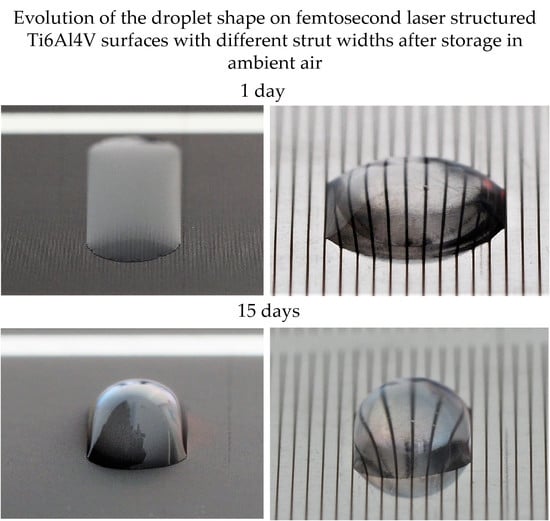Time-Dependent Anisotropic Wetting Behavior of Deterministic Structures of Different Strut Widths on Ti6Al4V
Abstract
1. Introduction
2. Materials and Methods
2.1. Materials
2.2. Laser Processing
2.3. Surface Characterization and Investigation of Wetting Properties
3. Results and Discussion
3.1. Surface Topography of Laser-Treated Surfaces
3.2. Contact Angle Measurements
4. Conclusions
Author Contributions
Funding
Conflicts of Interest
References
- Feng, L.; Li, S.; Li, Y.; Li, H.; Zhang, L.; Zhai, J.; Song, Y.; Liu, B.; Jiang, L.; Zhu, D. Super-Hydrophobic Surfaces: From Natural to Artificial. Adv. Mater. 2002, 14, 1857–1860. [Google Scholar] [CrossRef]
- Zheng, Y.; Gao, X.; Jiang, L. (Directional adhesion of superhydrophobic butterfly wings. Soft Matter 2007, 3, 178–182. [Google Scholar] [CrossRef]
- Xia, D.; He, X.; Jiang, Y.-B.; Lopez, G.P.; Brueck, S.R.J. Tailoring anisotropic wetting properties on submicrometer-scale periodic grooved surfaces. Langmuir 2010, 26, 2700–2706. [Google Scholar] [CrossRef]
- Vorobyev, A.Y.; Guo, C. Multifunctional surfaces produced by femtosecond laser pulses. J. Appl. Phys. 2015, 117, 33103. [Google Scholar] [CrossRef]
- Hwang, T.Y.; Vorobyev, A.Y.; Guo, C. Enhanced efficiency of solar-driven thermoelectric generator with femtosecond laser-textured metals. Opt. Express 2011, 19, A824–A829. [Google Scholar] [CrossRef] [PubMed]
- Nayak, B.K.; Iyengar, V.V.; Gupta, M.C. Efficient light trapping in silicon solar cells by ultrafast-laser-induced self-assembled micro/nano structures. Prog. Photovolt. Res. Appl. 2011, 19, 631–639. [Google Scholar] [CrossRef]
- Chung, J.Y.; Youngblood, J.P.; Stafford, C.M. Anisotropic wetting on tunable micro-wrinkled surfaces. Soft Matter 2007, 3, 1163. [Google Scholar] [CrossRef]
- Yoshimitsu, Z.; Nakajima, A.; Watanabe, T.; Hashimoto, K. Effects of Surface Structure on the Hydrophobicity and Sliding Behavior of Water Droplets. Langmuir 2002, 18, 5818–5822. [Google Scholar] [CrossRef]
- Choi, W.; Tuteja, A.; Mabry, J.M.; Cohen, R.E.; McKinley, G.H. A modified Cassie-Baxter relationship to explain contact angle hysteresis and anisotropy on non-wetting textured surfaces. J. Colloid. Interface Sci. 2009, 339, 208–216. [Google Scholar] [CrossRef]
- Lee, D.-K.; Choi, S.Y.; Park, M.S.; Cho, Y.H. Wetting properties of hybrid structure with hydrophilic ridges and hydrophobic channels. Appl. Phys. A 2018, 124, 308. [Google Scholar] [CrossRef]
- Dorrer, C.; Rühe, J. Advancing and receding motion of droplets on ultrahydrophobic post surfaces. Langmuir 2006, 22, 7652–7657. [Google Scholar] [CrossRef] [PubMed]
- Neuhaus, S.; Spencer, N.D.; Padeste, C. Anisotropic wetting of microstructured surfaces as a function of surface chemistry. ACS Appl. Mater. Interfaces 2012, 4, 123–130. [Google Scholar] [CrossRef] [PubMed]
- Li, P.; Xie, J.; Cheng, J.; Wu, K.K. Anisotropic wetting properties on a precision-ground micro-V-grooved Si surface related to their micro-characterized variables. J. Micromech. Microeng. 2014, 24, 75004. [Google Scholar] [CrossRef]
- Chen, F.; Zhang, D.; Yang, Q.; Wang, X.; Dai, B.; Li, X.; Hao, X.; Ding, Y.; Si, J.; Hou, X. Anisotropic wetting on microstrips surface fabricated by femtosecond laser. Langmuir 2011, 27, 359–365. [Google Scholar] [CrossRef]
- Martínez-Calderon, M.; Rodríguez, A.; Dias-Ponte, A.; Morant-Miñana, M.C.; Gómez-Aranzadi, M.; Olaizola, S.M. Femtosecond laser fabrication of highly hydrophobic stainless steel surface with hierarchical structures fabricated by combining ordered microstructures and LIPSS. Appl. Surf. Sci. 2016, 374, 81–89. [Google Scholar] [CrossRef]
- Long, J.; Zhong, M.; Zhang, H.; Fan, P. Superhydrophilicity to superhydrophobicity transition of picosecond laser microstructured aluminum in ambient air. J. Colloid. Interface Sci. 2015, 441, 1–9. [Google Scholar] [CrossRef]
- Kietzig, A.-M.; Hatzikiriakos, S.G.; Englezos, P. Patterned superhydrophobic metallic surfaces. Langmuir 2009, 25, 4821–4827. [Google Scholar] [CrossRef]
- Schnell, G.; Staehlke, S.; Duenow, U.; Nebe, J.B.; Seitz, H. Femtosecond Laser Nano/Micro Textured Ti6Al4V Surfaces—Effect on Wetting and MG-63 Cell Adhesion. Materials 2019, 12, 2210. [Google Scholar] [CrossRef]
- Vorobyev, A.Y.; Guo, C. Direct femtosecond laser surface nano/microstructuring and its applications. Laser Photonics Rev. 2013, 7, 385–407. [Google Scholar] [CrossRef]
- Jagdheesh, R.; Diaz, M.; Ocaña, J.L. Bio inspired self-cleaning ultrahydrophobic aluminium surface by laser processing. RSC Adv. 2016, 6, 72933–72941. [Google Scholar] [CrossRef]
- Cardoso, J.T.; Garcia-Girón, A.; Romano, J.M.; Huerta-Murillo, D.; Jagdheesh, R.; Walker, M.; Dimov, S.S.; Ocaña, J.L. Influence of ambient conditions on the evolution of wettability properties of an IR-, ns-laser textured aluminium alloy. RSC Adv. 2017, 7, 39617–39627. [Google Scholar] [CrossRef]
- van den Brand, J.; van Gils, S.; Beentjes, P.C.J.; Terryn, H.; Wit, J.H.W. Ageing of aluminium oxide surfaces and their subsequent reactivity towards bonding with organic functional groups. Appl. Surf. Sci. 2004, 235, 465–474. [Google Scholar] [CrossRef]
- Bizi-Bandoki, P.; Benayoun, S.; Valette, S.; Beaugiraud, B.; Audouard, E. Modifications of roughness and wettability properties of metals induced by femtosecond laser treatment. Appl. Surf. Sci. 2011, 257, 5213–5218. [Google Scholar] [CrossRef]
- Huerta-Murillo, D.; García-Girón, A.; Romano, J.M.; Cardoso, J.T.; Cordovilla, F.; Walker, M.; Dimov, S.S.; Ocaña, J.L. Wettability modification of laser-fabricated hierarchical surface structures in Ti-6Al-4V titanium alloy. Appl. Surf. Sci. 2019, 463, 838–846. [Google Scholar] [CrossRef]
- Takeda, S.; Fukawa, M.; Hayashi, Y.; Matsumoto, K. Surface OH group governing adsorption properties of metal oxide films. Thin Solid Films 1999, 339, 220–224. [Google Scholar] [CrossRef]
- Gibbs, J.W.; Wilson, E.B.; Page, T. The Scientific Papers of J. Willard Gibbs: Vol. I. Thermodynamics, Elementary Principles in Statistical Mechanics and Vector Analysis. Am. J. Phys. 1962, 30, 313–314. [Google Scholar] [CrossRef]
- Kusumaatmaja, H.; Vrancken, R.J.; Bastiaansen, C.W.M.; Yeomans, J.M. Anisotropic drop morphologies on corrugated surfaces. Langmuir 2008, 24, 7299–7308. [Google Scholar] [CrossRef] [PubMed]
- Bayer, I.S.; Brandi, F.; Cingolani, R.; Athanassiou, A. Modification of wetting properties of laser-textured surfaces by depositing triboelectrically charged Teflon particles. Colloid. Polym. Sci. 2013, 291, 367–373. [Google Scholar] [CrossRef]
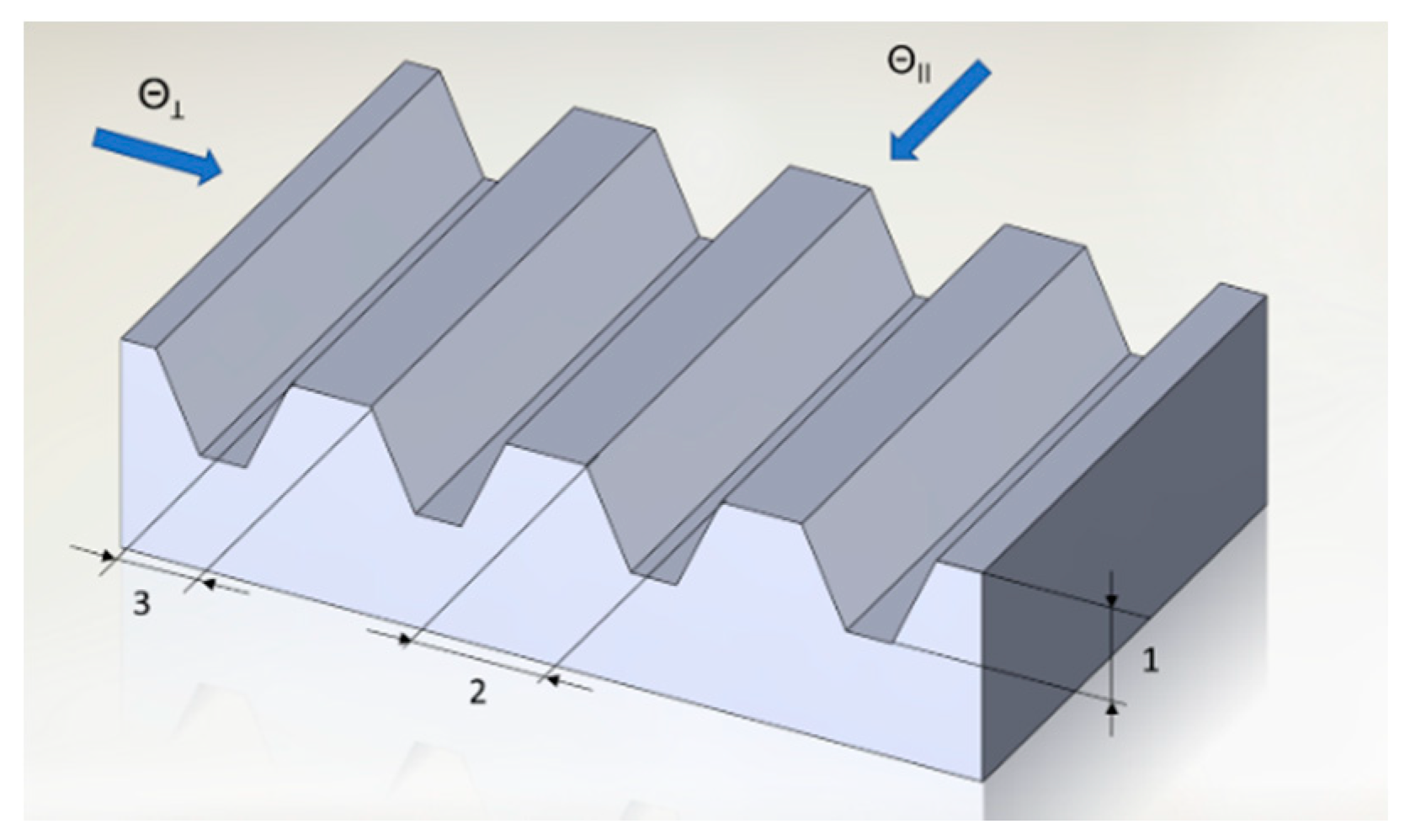
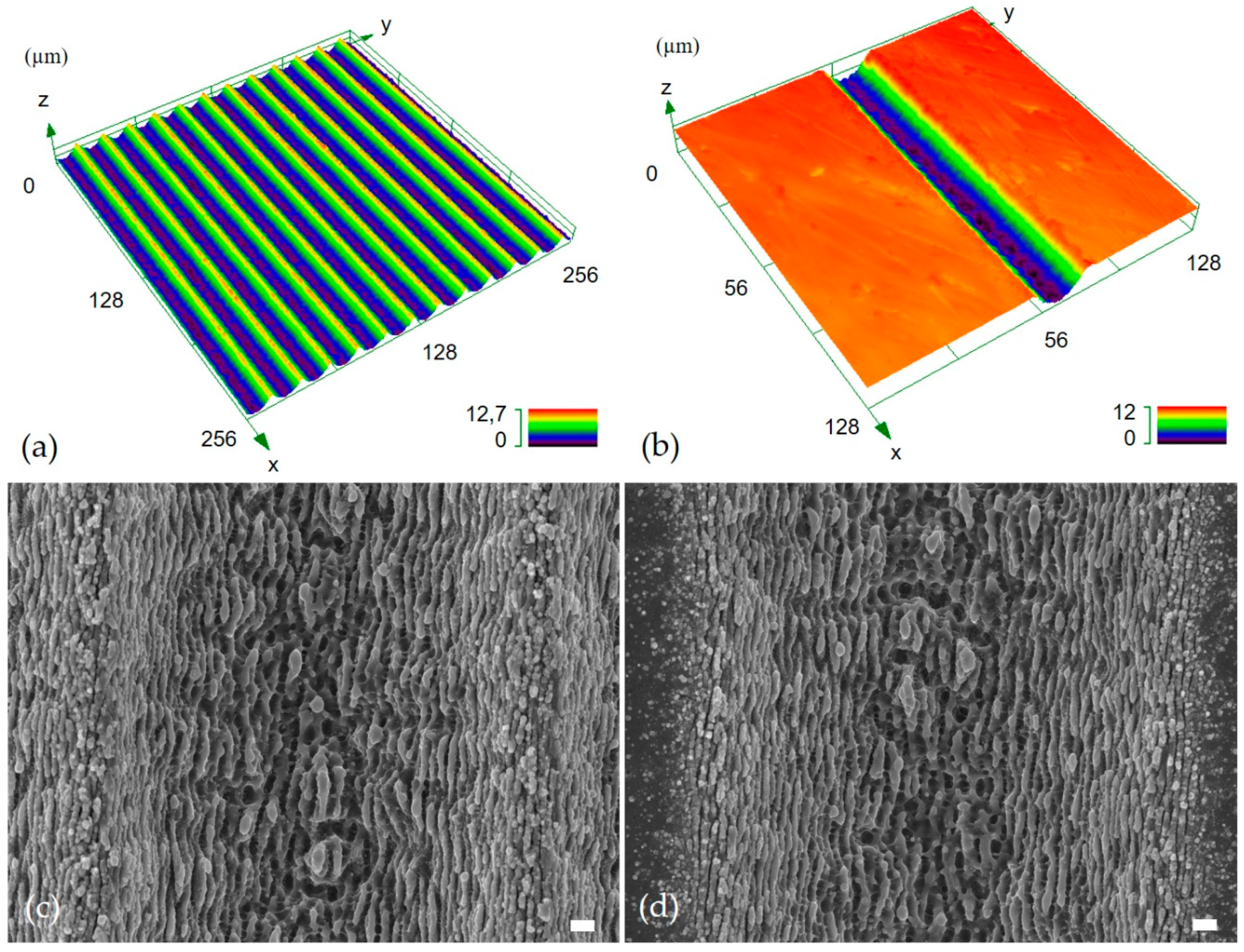



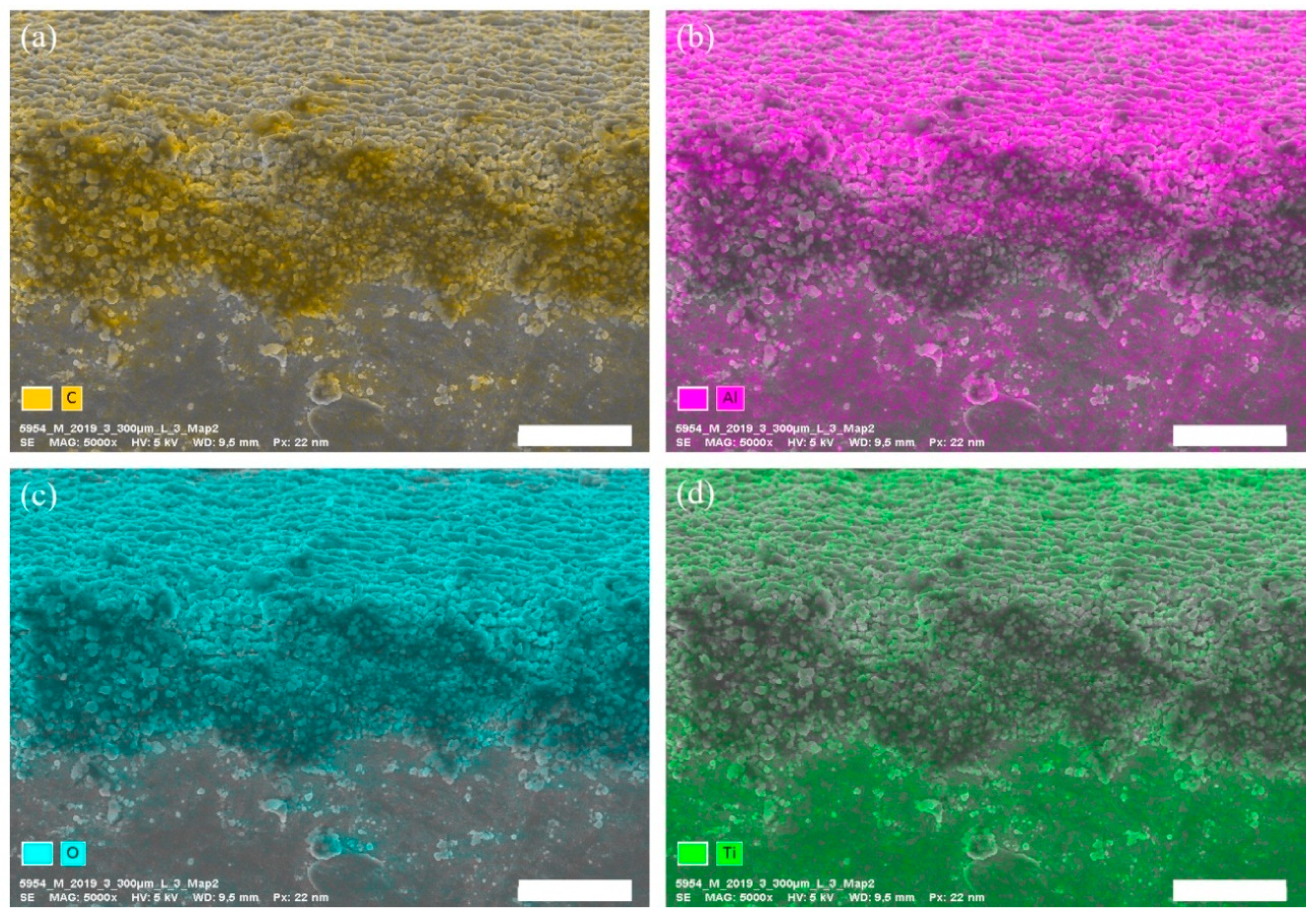
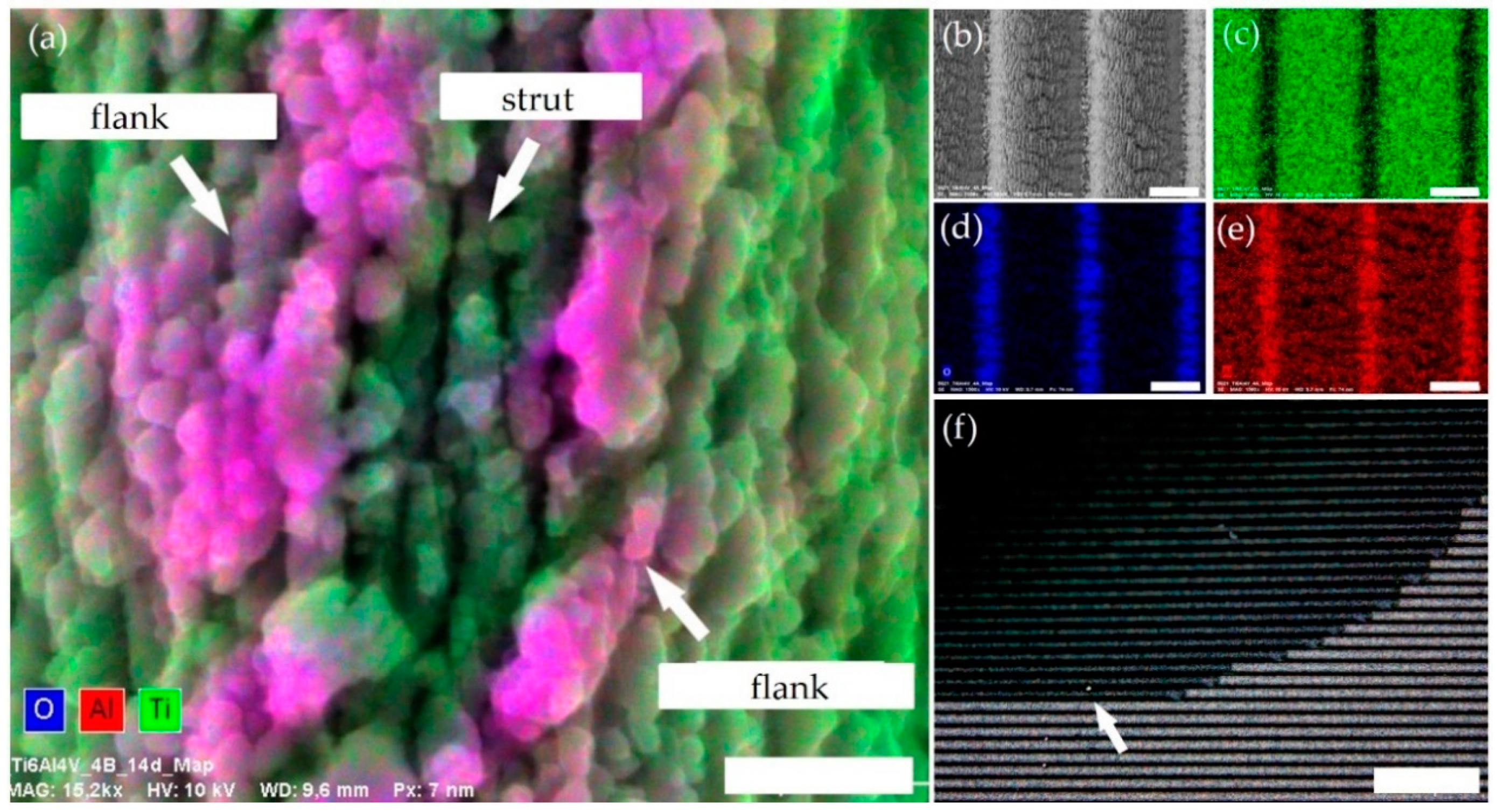
| Final Laser Parameter Settings | |
|---|---|
| Pulse energy (µJ) | 7 |
| Fluence in focus (J/cm2) | 1.37 |
| Line overlap (%) | 50 |
| Number of overscans (-) | 310 |
© 2019 by the authors. Licensee MDPI, Basel, Switzerland. This article is an open access article distributed under the terms and conditions of the Creative Commons Attribution (CC BY) license (http://creativecommons.org/licenses/by/4.0/).
Share and Cite
Schnell, G.; Jagow, C.; Springer, A.; Frank, M.; Seitz, H. Time-Dependent Anisotropic Wetting Behavior of Deterministic Structures of Different Strut Widths on Ti6Al4V. Metals 2019, 9, 938. https://doi.org/10.3390/met9090938
Schnell G, Jagow C, Springer A, Frank M, Seitz H. Time-Dependent Anisotropic Wetting Behavior of Deterministic Structures of Different Strut Widths on Ti6Al4V. Metals. 2019; 9(9):938. https://doi.org/10.3390/met9090938
Chicago/Turabian StyleSchnell, Georg, Christopher Jagow, Armin Springer, Marcus Frank, and Hermann Seitz. 2019. "Time-Dependent Anisotropic Wetting Behavior of Deterministic Structures of Different Strut Widths on Ti6Al4V" Metals 9, no. 9: 938. https://doi.org/10.3390/met9090938
APA StyleSchnell, G., Jagow, C., Springer, A., Frank, M., & Seitz, H. (2019). Time-Dependent Anisotropic Wetting Behavior of Deterministic Structures of Different Strut Widths on Ti6Al4V. Metals, 9(9), 938. https://doi.org/10.3390/met9090938





